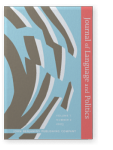The semiotics of metaphor
The conduit metaphor in Singapore’s language policy
This article investigates the role of metaphor in the production and reproduction of language ideologies. It does this by focusing on official discourses concerning the language policy of Singapore, where recurrent appeal is made to the conduit metaphor (Reddy 1993) in articulating various claims and beliefs about language and its relation to questions of identity and values.
The analytic framework adopted here treats language ideologies in terms of three semiotic processes: iconization, recursion, and erasure (Gal and Irvine 1995). By tracking a single metaphor through a variety of discourses, the article illustrates how these semiotic processes come together when metaphor is used in the service of ideology. The article also suggests the introduction of a fourth semiotic process, performativity, which draws attention to the various lexical realizations of the conduit metaphor.
References
Benjamin, Geoffrey
1976 The cultural logic of Singapore’s “multiracialism”. In:
Riaz Hassan (ed.).
Singapore: Society in transition. Kuala Lumpur: Oxford University Press, 115–33.

Bokhorst-Heng, Wendy
1998 Language and imagining the nation in Singapore. PhD. dissertation, University of Toronto.
Bokhorst-Heng, Wendy
1999 Singapore’s Speak Mandarin Campaign: Language ideological debates and the imagining of the nation. In:
Jan Blommaert (ed.).
Language ideological debates. Berlin: Mouton de Gruyter, 235–265.


Chilton, Paul A.
1996 Security metaphors: Cold war discourse from containment to common house. New York: Peter Lang.

Duranti, Alessandro and Charles Goodwin
(eds) 1992.
Rethinking context: Language as an interactive phenomenon. Cambridge: Cambridge University Press.

Errington, Joseph
1985 On the nature of the sociolinguistic sign: Describing the Javanese speech levels. In:
Elizabeth Mertz and
Richard Parmentier (eds).
Semiotic mediation. Orlando, Fla.: Academic Press, 287–310.


Fishman, Joshua A.
1989 Language and ethnicity in minority sociolinguistic perspective. Clevedon: Multilingual Matters.

Foley, William A.
1997 Anthropological linguistics: An introduction. Oxford: Blackwell.

Gal, Susan
1998 Multiplicity and contention among language ideologies: A commentary. In:
Bambi B. Schieffelin,
Kathryn A. Woolard and
Paul V. Kroskrity (eds).
Language ideologies: Practice and theory. Oxford: Oxford University Press, 317–331.

Gal, Susan and Judith T. Irvine
1995 The boundaries of languages and disciplines: How ideologies construct difference.
Social Research 62(4), 967–1001.

Gopinathan, S.
1976 Towards a national educational system. In:
Riaz Hassan (ed.).
Singapore: Society in transition. Kuala Lumpur: Oxford University Press, 67–83.

Holyoak, Keith J. and Paul Thagard
1995 Mental leaps: Analogy in creative thought. Cambridge, Mass.: MIT Press.

Irvine, Judith T.
1989 When talk isn’t cheap: Language and political economy.
American Ethnologist 161, 248–267.


Johnson, Mark
1987 The body in the mind: The bodily basis of meaning, imagination, and reason. Chicago: University of Chicago Press.


Kuipers, Joel C.
1998 Language, identity, and marginality in Indonesia. Cambridge: Cambridge University Press.


Labov, William
1979 Locating the frontier between social and psychological factors in linguistic variation. In:
Charles J. Fillmore,
Daniel Kempler, and
William S-Y. Wang (eds).
Individual differences in language ability and language behaviour. New York: Academic Press, 327–339.


Lakoff, George and Mark Johnson
1980 Metaphors we live by. Chicago: Chicago University Press.

Lakoff, George and Mark Turner
1989 More than cool reason: A field guide to poetic metaphor. Chicago: Chicago University Press.


Pakir, Anne
1992 English-knowing bilingualism in Singapore. In:
Ban Kah Choon,
Anne Pakir and
Tong Chee Kiong (eds).
Imagining Singapore. Singapore: Times Academic Press, 234–262.

Pakir, Anne
1993 Two tongue-tied: Bilingualism in Singapore.
Journal of Multilingual and Multicultural Development 14(1 & 2), 73–90.


Pennycook, Alistair
1998 English and the discourses of colonialism. London: Routledge.

Reddy, Michael J.
1993 The conduit metaphor: A case of frame conflict in our language about language. In:
Andrew Ortony (ed).
Metaphor and thought, 2nd edition. Cambridge: Cambridge University Press, 164–201.


Schön, Donald A.
1993 Generative metaphor: A perspective on problem-setting in social policy. In:
Andrew Ortony (ed).
Metaphor and thought, 2nd edition. Cambridge: Cambridge University Press, 137–163.


Silverstein, Michael
1979 Language structure and linguistic ideology. In:
Paul R Clyne,
William F. Hanks, and
Carol L. Hofbauer (eds).
The elements: A parasession on linguistic units and levels. Chicago: Chicago Linguistic Society, 193–247.

Spitulnik, Debra
1998 Mediating unity and diversity: The production of language ideologies in Zambian broadcasting. In:
Bambi B. Schieffelin,
Kathryn A. Woolard and
Paul V. Kroskrity (eds).
Language ideologies: Practice and theory. Oxford: Oxford University Press, 163–188.

Straehle, Carolyn, Gilbert Weiss, Ruth Wodak, Peter Muntigl and Maria Sedlak
1999 Struggle as metaphor in European Union discourses on unemployment.
Discourse and Society 10(1), 67–99.


Wee, Lionel
2001 Divorce before marriage in the Singapore-Malaysia relationship: The Invariance Principle at work.
Discourse and Society 12(4), 535–549.


Whorf, Benjamin
1956 Language, thought and reality: Selected writings of Benjamin Lee Whorf. Cambridge, MA: MIT Press.

Cited by
Cited by 2 other publications
Park, Joseph Sung-Yul & Lionel Wee
2008.
Appropriating the language of the other: Performativity in autonomous and unified markets.
Language & Communication 28:3
► pp. 242 ff.

Wee, Lionel
2006.
The semiotics of language ideologies in Singapore1.
Journal of Sociolinguistics 10:3
► pp. 344 ff.

This list is based on CrossRef data as of 2 april 2024. Please note that it may not be complete. Sources presented here have been supplied by the respective publishers.
Any errors therein should be reported to them.
